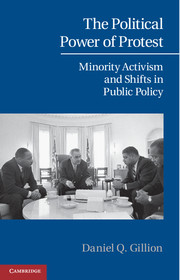Book contents
- Frontmatter
- Contents
- List of Figures
- List of Tables
- Preface
- Acknowledgments
- Introduction
- 1 A Continuum of Information
- 2 Measuring Information in Minority Protest
- 3 Viewing Minority Protest from the Hill
- 4 Knocking on the President’s Door
- 5 Appealing to an Unlikely Branch
- Conclusion
- Appendix A Defining Minority Political Protest
- Appendix B Study Description and Coding Across Multiple Institutions
- Appendix C Time Series Methods
- References
- Index
2 - Measuring Information in Minority Protest
Published online by Cambridge University Press: 05 February 2013
- Frontmatter
- Contents
- List of Figures
- List of Tables
- Preface
- Acknowledgments
- Introduction
- 1 A Continuum of Information
- 2 Measuring Information in Minority Protest
- 3 Viewing Minority Protest from the Hill
- 4 Knocking on the President’s Door
- 5 Appealing to an Unlikely Branch
- Conclusion
- Appendix A Defining Minority Political Protest
- Appendix B Study Description and Coding Across Multiple Institutions
- Appendix C Time Series Methods
- References
- Index
Summary
In Chapter 1, I established a theoretical foundation for understanding the direct influence of political protest. I argued that the social context of racial and ethnic minority protest was informative to the federal government and allowed politicians to be more responsive to the scope of citizens’ behavior. This chapter introduces a new measure of minority protest that captures the scope of citizens’ political action. It then employs this measure to consider the geographical and temporal distribution of minority protest. Not only does minority protest provide stronger informational cues in some geographical locations than others, but the strength of minority voices has fluctuated over time. Over the period of study, the cues provided by political protest have become less informative to politicians, and so has the importance of race relations. The chapter concludes with a discussion of the influence of protest events on national public perceptions of race.
Existing Approaches to Measuring Minority Protest
There are several ways to define what constitutes a minority protest event and even more ways to measure these varying definitions. The most direct approach is to examine only whether or not a collective political event occurred. This measure is straightforward and has often been used to assess movement and individual behavior around protest activities. Simply asking whether a protest event occurred, however, ignores the contextual factors that shaped the impact of citizens’ behavior on government response.
- Type
- Chapter
- Information
- The Political Power of ProtestMinority Activism and Shifts in Public Policy, pp. 39 - 56Publisher: Cambridge University PressPrint publication year: 2013



